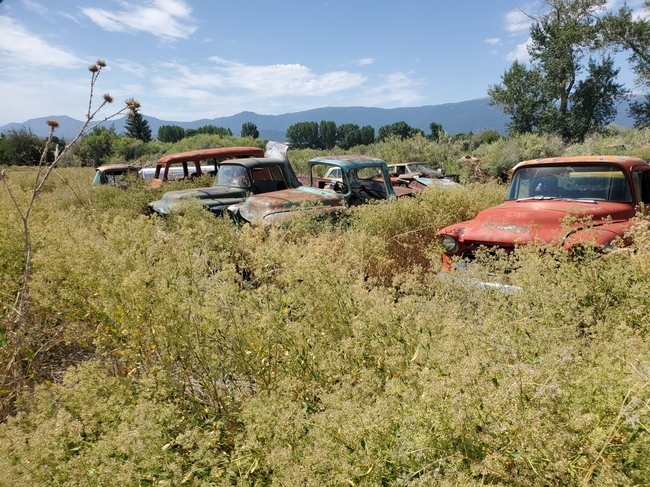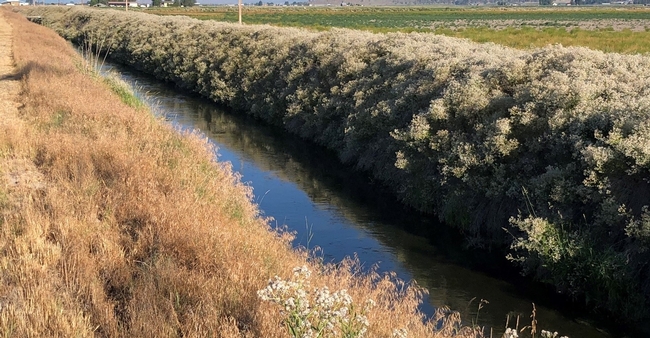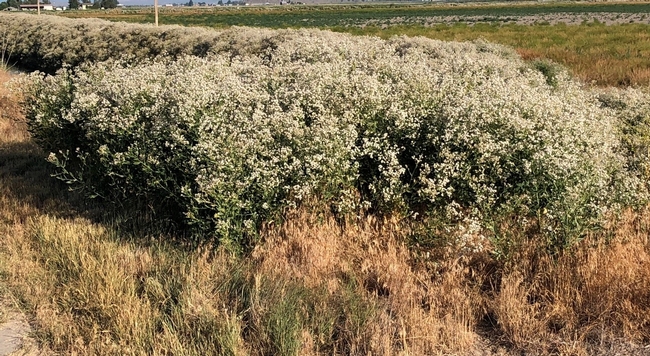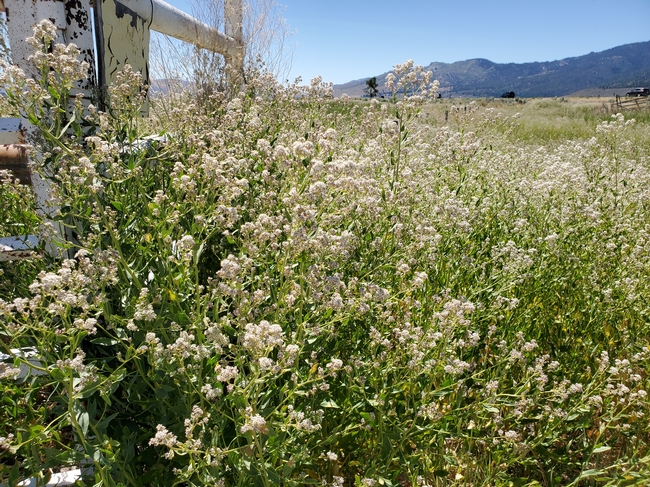Does this weed look familiar?
Perennial pepperweed (Lepidium latifolium) also known as tall whitetop is a root-creeping perennial weed. It is commonly found along roadsides, ditches, and drains. It is also a big problem in pastures, non-cropland, and even cropland that is not tilled on a yearly basis. Perennial pepperweed spreads by seed and root fragments and is very persistent and difficult to control once established.
I've been amazed at the number of perennial pepperweed patches flowering along the road and ditches this year. The plants' tiny white flowers make it easy to locate patches this time of the year, and I challenge anyone to drive more than one mile on county roads without seeing a patch on public or private property. While dry seeds do not float, once submerged in water they can form a mucus membrane trapping air and allowing them to move with water. Anyone who has driven through Susanville or Reno can attest to this weeds propensity to take over river bottoms and floodplains. Lower Klamath Wildlife Refuge is another example of how this weed can form dense, impenetrable stands. Due to its invasive nature, I encourage local landowners to take this weed seriously and aggressively treat this weed on your property. Perennial pepperweed is much easier to control when patches are small versus large impenetrable stands that can engulf fences, ditches, and even large farm equipment. It is a nasty, invasive weed that displaces much more desirable vegetation.
The key to managing perennial pepperweed is suppressing its extensive underground root system. The plant mainly spreads by roots and can resprout from root fragments buried deep in the soil. Hand-pulling is effective for single plants and seedlings, but hand-pulling will quickly become overwhelming in patches with hundreds of stems. Cultivation/tillage can be effective at suppressing plants and preventing new plants from becoming established, but it also a great way to spread root fragments. Tillage is NOT effective at killing well-established plants and large infestations as the broken root fragments quickly re-sprout.
Herbicides are an effective tool for managing perennial pepperweed, but herbicide choice, herbicide rate, and application timing are extremely important to obtain good control. Herbicides are most effective applied at the flowerbud to flowering stage. 2,4-D, chlorsulfuron (Telar), imazapyr, and glyphosate are effective herbicide active ingredients for perennial pepperweed (sold under several trade names). It is important to follow label directions and recommended rates for perennial pepperweed as higher rates are necessary to control this deep-rooted plant compared to annual weeds such as pigweed and lambsquarter. Keep in mind a single herbicide application rarely eradicates a patch. Yearly re-treatment for multiple years is often necessary for eradication. Another important consideration when using herbicides is to preserve desirable vegetation such as perennial grasses after controlling perennial pepperweed. Perennial pepperweed tends to choke out desirable grasses over time, thus bare ground and exposed soil is common after successful control of this weed. In these cases, desirable vegetation needs to be re-seeded or re-established to prevent perennial pepperweed or other weeds from invading the areas with bare ground.
In areas where pepperweed patches are young and there are there are still desirable perennial grasses, broadleaf selective herbicides such as 2,4-D or chlorsulfuron can control the pepperweed while releasing the grasses from competition. For spots that will need to be replanted, 2,4-D or glyphosate may be a better choice, as it can take years for seeds to germinate in areas treated with chlorsulfuron or imazapyr. Imazapyr can be a good choice where bare ground is a desirable outcome, but should not be used around desirable vegetation as it can move in the soil. Chlorsulfuron can also move with soil so do not use this herbicide on ditches and along crop field borders. The herbicide you choose should be dependent on where the pepperweed is growing and what else is growing with it.

Attached Images:

